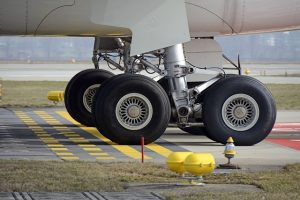
Modern-day airplanes are designed with a variety of automated systems. In addition to autopilot, for instance, many of them feature an automatic braking system. Known as autobrakes, it’s used during landings and rejected takeoffs. To learn more about autobrakes and how it works, keep reading.
Overview of Autobrakes
Autobrakes are automatic hydraulic braking systems. They are designed to decelerate airplanes during landings and rejected takeoffs.
Pilots, of course, can always engage the airplane’s brakes manually. Many airplanes feature disc brakes that are similar to automotive brakes. When engaged, a pair of calipers will squeeze the brake pads against the landing gear’s rotors. Autobrakes, in comparison, are completely automated. Autobrakes work automatically to slow down the airplane during landings and rejected takeoffs.
How Autobrakes Work
You might be wondering how autobrakes work exactly. While there are different types of autobrake systems, most of them require manual arming. The pilot must manually arm the airplane’s autobrake system. The autobrake system will then take over by automatically applying braking pressure.
The rate of deceleration associated with autobrakes varies depending on the settings. Pilots can configure autobrakes for faster or slower deceleration. In most scenarios, a slower rate of deceleration is preferred. This reduces unnecessary stress on the airplane’s brakes and landing gear.
Benefits of Autobrakes
Autobrakes offer several benefits, one of which is even and uniform deceleration. Pilots can always use the airplane’s manual brakes. The problem with manual brakes, though, is that it fails to achieve the same even and uniform rate of deceleration. With autobrakes, the airplane will decelerate more evenly.
Another benefit of autobrakes is that it allows pilots to perform other tasks. Pilots don’t have to focus on braking. Instead, they can perform other tasks associated with landing or controlling the airplane.
Autobrakes are also used for rejected takeoffs. A rejected takeoff is an aborted takeoff. There are autobrake systems that are designed to decelerate airplanes during instances of rejected takeoffs.
It’s also worth noting that stopping distances are more consistent with autobrakes. This is because autobrakes apply even and consistent brake pressure — something that’s difficult to achieve with manual brakes. As a result, pilots can better predict where the airplane will stop.
In Conclusion
Autobrakes are exactly what they sound like: braking systems that work automatically. They are typically used during landings and rejected takeoffs.



